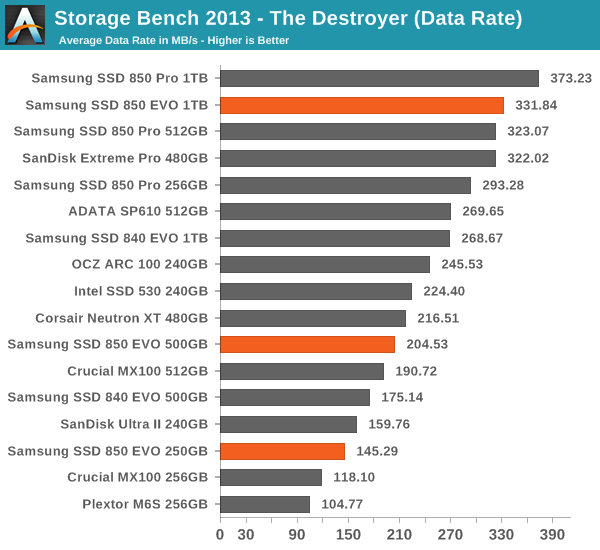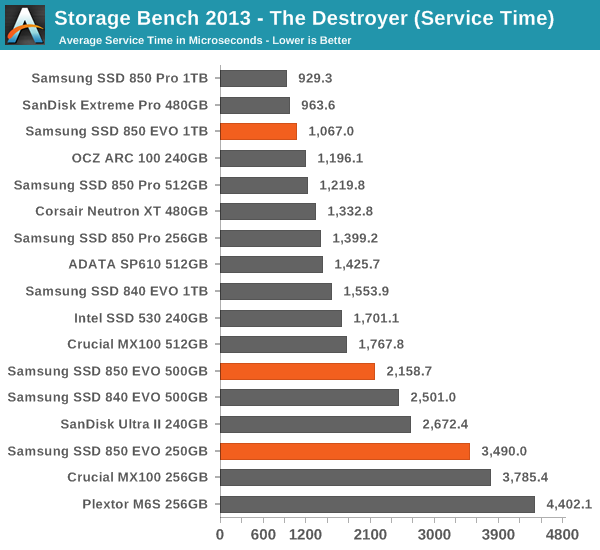Samsung SSD 850 EVO (120GB, 250GB, 500GB & 1TB) Review
by Kristian Vättö on December 8, 2014 10:00 AM ESTAnandTech Storage Bench 2013
Our Storage Bench 2013 focuses on worst-case multitasking and IO consistency. Similar to our earlier Storage Benches, the test is still application trace based – we record all IO requests made to a test system and play them back on the drive we are testing and run statistical analysis on the drive's responses. There are 49.8 million IO operations in total with 1583.0GB of reads and 875.6GB of writes. I'm not including the full description of the test for better readability, so make sure to read our Storage Bench 2013 introduction for the full details.
| AnandTech Storage Bench 2013 - The Destroyer | ||
| Workload | Description | Applications Used |
| Photo Sync/Editing | Import images, edit, export | Adobe Photoshop CS6, Adobe Lightroom 4, Dropbox |
| Gaming | Download/install games, play games | Steam, Deus Ex, Skyrim, Starcraft 2, BioShock Infinite |
| Virtualization | Run/manage VM, use general apps inside VM | VirtualBox |
| General Productivity | Browse the web, manage local email, copy files, encrypt/decrypt files, backup system, download content, virus/malware scan | Chrome, IE10, Outlook, Windows 8, AxCrypt, uTorrent, AdAware |
| Video Playback | Copy and watch movies | Windows 8 |
| Application Development | Compile projects, check out code, download code samples | Visual Studio 2012 |
We are reporting two primary metrics with the Destroyer: average data rate in MB/s and average service time in microseconds. The former gives you an idea of the throughput of the drive during the time that it was running the test workload. This can be a very good indication of overall performance. What average data rate doesn't do a good job of is taking into account response time of very bursty (read: high queue depth) IO. By reporting average service time we heavily weigh latency for queued IOs. You'll note that this is a metric we have been reporting in our enterprise benchmarks for a while now. With the client tests maturing, the time was right for a little convergence.

The faster NAND and better IO consistency results in increased performance in our 2013 Storage Bench. The 1TB version shines in the test and isn't far from the 850 Pro, but the 500GB and 250GB models end up being middle-class performers. Especially the performance of the 250GB model is a bit underwhelming because it is beaten by the Ultra II, even though the 850 EVO should have a performance advantage thanks to V-NAND.











97 Comments
View All Comments
Kevin G - Monday, December 8, 2014 - link
They do seem a little low but we just got out of a major sale spree. During the Black Friday/Cyber Monday shopping fest the 480 GB Intel 730 was going for $200. I would have picked up one up myself at that price but they ran out of stock.HisDivineOrder - Wednesday, December 10, 2014 - link
You'd have been better served with the Sandisk Extreme Pro 480GB for $185.davolfman - Monday, December 8, 2014 - link
OCZ's firmware for the Barefoot3 series of chips the ARC100 uses has a less then stellar reputation. Things like unexpected power loss have been known to put it into a state of progressive corruption only recoverable by secure erase. There have been patches that claim to fix this on my Vector (that probably got applied to the ARC out the door), but I haven't seen anyone test if they're working.Oxford Guy - Wednesday, December 31, 2014 - link
Up to its old tricks, then.Kristian Vättö - Tuesday, December 9, 2014 - link
As listed on the table, the prices were taken on December 7 and were accurate at the time.sheh - Monday, December 8, 2014 - link
Can anyone explain the large discrepancy (not only in this case) in sequential speed between Iometer and AS-SSD?Kristian Vättö - Tuesday, December 9, 2014 - link
It's because of TurboWrite. Iometer is a time based tool and the sequential tests are run for one minute, which means that the TurboWrite buffer will be filled and thus the performance goes down as data is written to the TLC array. AS-SSD, on the other hand, only writes a gigabyte of data so it all gets written to the fast SLC cache.sheh - Friday, December 12, 2014 - link
Thanks. I'll have to reread older reviews, but I think there's a similar behavior also on other drives that do not have a fast temporary buffer?maecenas - Monday, December 8, 2014 - link
I saw the 840 EVO 500gb going for $180 over the black Friday - cyber Monday period. It'll interesting to see if Samsung keep the 840 EVO on the market as a the low end, so the 850 EVO can fill the mid-range portion of the market while the 850 Pro serves the high end.Laststop311 - Monday, December 8, 2014 - link
Prices are kinda crappy. Why go with an 850 evo when u can spend 20-30 dollars more and get an 850 pro?